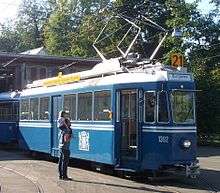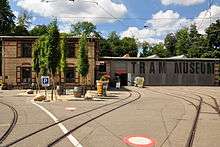Zürich Tram Museum
| Tram-Museum Zürich | |
|
| |
| Established | 1968 |
|---|---|
| Location |
Forchstrasse 260 8008 Zürich Switzerland |
| Coordinates | 47°21′27″N 8°34′18″E / 47.3576°N 8.5716°ECoordinates: 47°21′27″N 8°34′18″E / 47.3576°N 8.5716°E |
| Type | Transport museum |
| Public transit access | Zürich tram route 11 |
| Website |
tram-museum |
The Zürich Tram Museum (German: Tram-Museum Zürich) is a transport museum in the Swiss city of Zürich, specialising in the history of the Zürich tram system. The main museum site is located at the former tram depot, Tramdepot Burgwies. The museum also maintains a workshop at the much smaller former tram depot of Wartau.[1][2][3]
The tram museum is run by an association, the Verein Tram Museum Zürich, which has some 500 members, and is responsible for looking after the exhibits of the museum. The tram cars remain in the ownership of the Verkehrsbetriebe Zürich, the city-owned operator of the Zürich tram system.[4]
History

The tram museum was founded in 1968. At first it used various borrowed locations to store and work on its exhibits. In 1989 it took over the tiny former de:Strassenbahn Zürich–Höngg (StZH) tram depot at Wartau, which had been out of use as a tram depot since the 1923 acquisition of the StZH by the city, and opened its first public museum. The new museum was just big enough to hold five preserved trams.[1][5]
In 2008, the museum moved to the significantly larger former tram depot at Burgwies, although Wartau has been retained as a workshop and store.[1]
Access

The main museum site at Burgwies is open to the public on several days a week, with exact opening hours varying by day of the week and season of the year. The museum is located by the Bergweis tram stop, on tram route 11 at the boundary of the city's Weinegg and Hirslanden quarters. The museum also runs an occasional historic tram service between Burgwies and the city centre, billed as tram route 21. Route 21 operates on both days of the last weekend of each month, providing a half-hourly frequency in summer and an hourly frequency in winter, during museum opening hours.[2][6][7]
The site at Wartau is located on tram route 13 in the Höngg quarter, but is not normally open to the public.
Collection
Tram fleet
The museum's collection includes about 20 preserved tram cars, the majority of which are operational. In addition to cars from Zürich's city owned fleet, the collection includes cars from the private companies that operated routes around Zürich in the early days. Cars from the city fleet demonstrate changes in design over time, from cars very similar to these early private sector vehicles, through the 1930s Elefant bogie cars and 1940s Swiss Standard Tram cars, to trams recently retired.[1]
The preserved tram fleet of the museum includes the following vehicles:
| Number | Type | Year | Notes | Image |
|---|---|---|---|---|
| 1 | Ce 2/2 | 1897 | Two-axle motor tram originally built for the de:Strassenbahn Zürich-Oerlikon-Seebach (ZOS) and preserved in their green livery. This is the oldest operable electric tram car in Switzerland.[8][9] | |
| 2 | Ce 2/2 | 1900 | Motor tram originally built for the de:Limmattal-Strassenbahn and preserved in their yellow livery. Known as Lisbethli.[8][10] |  |
| 2 | 1907 | Motor tram originally built for the de:Albisgütlibahn and sold to the Bex–Villars–Bretaye Railway (BVB) in 1953. Numbered 8 by the BVB. Returned to Zürich for preservation in 2006.[11][12] | ||
| 2 | Ce 2/2 | 1928 | Two axle motor tram built for the Städtische Strassenbahn Zürich of a class popularly known as schnelläufer (fast runner).[8] |  |
| 102 | Two-axle motor tram. |  | ||
| 119 | B | 1935 | Light rail trailer car originally from the Lausanne tramway, acquired by the Forchbahn in 1962 and preserved in the latter's red livery. Because of its origins, popularly known as lausanner.[8][13] | |
| 176 | Ce 2/2 | 1909 | Two-axle motor tram. A later and updated version of the design seen in car 102, with a riveted frame and four larger windows in place of 102's five windows, this is the youngest car in the museum to retain longitudinal seating.[8][14] |  |
| 321 | Ce 4/4 | 1930 | Four-axle centre-entrance motor tram. One of a class of 50 similar vehicles popularly known by the name elefant (elephant). With a weight of 27 tonnes and four 80 hp motors, these cars were used to haul up to three two-axle trailers over Zürich's considerable gradients.[15] |  |
| 626 | Tram trailer. |  | ||
| 687 | C | 1931 | Tram trailer.[8] |  |
| 732 | Tram trailer | |||
| 1392 | Be 4/4 | 1950 | Swiss Standard Tram – four-axle motor tram of a type popularly known as kurbeli.[16] |  |
| 1430 | Be 4/4 | 1960 | Motor tram of a type popularly known as karpfen (carp).[8] |  |
| 1530 | Be 4/4 | 1949 | Swiss Standard Tram – four-axle motor tram of a type popularly known as pedaler.[8] |  |
| 1675 | Be 4/6 | Six-axle, three section articulated tram of a type popularly known as mirage.[17] |  | |
| 1905 | Xe 2/2 | 1962 | Depot shunter popularly known as laubfrosch (tree frog). Built in 1962 using parts from withdrawn trams, its open construction and single central controller was an efficient design for shunting trailer cars, used especially during peak periods.[8] |  |
| 1935 | Xe 2/2 | 1914 | Motor works car popularly known as besenwagen (broom wagon).[8] |  |
Other exhibits

The museum also includes a mezzanine level with smaller exhibits. These include a model tramway layout illustrating the city's street scene over the years, together with a selection of documents and photographs. The museum shop stocks a selection of books, postcards, models and souvenirs.[1][2]
The museum building, the former Tramdepot Burgwies, is also a significant exhibit in its own right, and is shared with a branch of the Migros supermarket chain. The building is inscribed on the Swiss Inventory of Cultural Property of National Significance.[18]
References
- 1 2 3 4 5 "Zürich celebrates its new tram museum". www.proactiva.ch. Archived from the original on 2016-08-17. Retrieved 2011-09-10.
- 1 2 3 "Zürich Tram Museum". Zürich Tram Museum. Archived from the original on 2016-08-17. Retrieved 2016-08-16.
- ↑ "Wartau open day, and farewell to 93". www.proactiva.ch. Archived from the original on 2016-08-17. Retrieved 2011-09-10.
- ↑ "Zürich Tram Museum Club". Zürich Tram Museum. Archived from the original on 2016-08-17. Retrieved 2016-08-16.
- ↑ "Die Strassenbahn Zürich - Höngg (Z-H), 1898 - 1924" (in German). Tram-Museum Zürich. 2003-10-11. Archived from the original on 2011-09-01. Retrieved 2015-07-22.
- ↑ "OpenStreetMap @ 47.35804/8.57151". OpenStreetMap contributors. Archived from the original on 2016-08-17. Retrieved 2014-03-17.
- ↑ "Museumslinie 21 - Fahrplan" [Museum line 21 - The Timetable] (PDF) (in German). Zürich Tram Museum. Archived (PDF) from the original on 2016-08-17. Retrieved 2016-08-17.
- 1 2 3 4 5 6 7 8 9 10 Information displayed on car in museum (in German). Tram-Museum Zürich. Retrieved 2011-09-24.
- ↑ "ZOS Ce 2/2 1" (in German). Tram-Museum Zürich. Archived from the original on 2010-06-30. Retrieved 2011-11-11.
- ↑ "LSB Ce 2/2 2" (in German). Tram-Museum Zürich. Archived from the original on 2010-06-02. Retrieved 2011-11-11.
- ↑ "News roundup". www.proaktiva.ch. Archived from the original on 2016-08-17. Retrieved 2012-02-05.
- ↑ "Former Albisgüetli tram in Kärnten". www.proaktiva.ch. Archived from the original on 2016-08-17. Retrieved 2012-02-05.
- ↑ "Anhängewagen B 119" [Trailer car B 119] (in German). Verein zur förderung historischer Forchbahnfahrzeuge. Archived from the original on 2013-09-27. Retrieved 2013-09-19.
- ↑ "Ce 2/2 176" (in German). Tram-Museum Zürich. Archived from the original on 2010-06-02. Retrieved 2011-11-11.
- ↑ "Ce 4/4 321" (in German). Tram-Museum Zürich. Archived from the original on 2006-05-21. Retrieved 2011-11-11.
- ↑ "Photo tour with Kurbeli on 22nd April". www.proaktiva.ch. Archived from the original on 2016-08-17. Retrieved 2011-11-11.
- ↑ "Mirages for tram museum". www.proactiva.ch. Archived from the original on 2016-10-03. Retrieved 2016-10-03.
- ↑ "Schweizerisches Inventar der Kulturgüter von nationaler Bedeutung - Zürich" [Swiss Inventory of Cultural Property of National Significance - Zürich] (PDF) (in German). Swiss Confederation. 2011. Archived from the original (PDF) on 2011-08-29. Retrieved 2011-09-13.
External links
 Media related to Tram-Museum Zürich at Wikimedia Commons
Media related to Tram-Museum Zürich at Wikimedia Commons- Zurich Tram Museum official web site